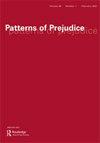The longue durée of transnational white nationalism
IF 0.8
2区 社会学
Q4 ETHNIC STUDIES
引用次数: 0
Abstract
This edited collection originated from a workshop at Trinity College, Dublin in 2017. If the book’s origins were a response to the societal shocks in 2016 of Brexit and the election of Donald Trump as President of the United States, then its publication in 2020 coincided with the global protests for social and racial justice in response to the police murder of George Floyd (xv). In the three years between the book’s conception and publication, there was a wave of extreme-right terrorist attacks that provided ample evidence of the global dangers of white nationalist violence. These included murderous attacks on synagogues and mosques in London in the United Kingdom, Pittsburgh in the United States, in Christchurch, New Zealand and in Halle, Germany, as well as other mass casualty incidents motivated by white supremacy. More recently, of course, we saw a mob of Trump supporters—including members of several extreme right groups—attack the US Capitol building. One of this book’s greatest strengths is to demonstrate that the extreme right’s imaginary of ethnic purity and ‘cleansing’ violence has long historical roots imbricating with the racial brutality of slavery and colonialism. The origins of the transnational networking and ideological cross-pollination of extreme-right organizations date back deep into the twentieth century (4). Although the book focuses on Anglophonic right-wing extremism, it makes a significant contribution to a body of recent scholarship that has delineated the transnational history of the global far right to include nonEnglish-language-speaking countries. The book consists of an introduction and nine case study chapters ordered into four sections: ‘In the shadow of slavery and empire’, ‘Opposing civil rights’, ‘Nostalgia for white rule’ and ‘The far right in the Anglosphere’.跨国白人民族主义的长期存在
这本经过编辑的合集源于2017年都柏林三一学院的一次研讨会。如果说这本书的起源是对2016年英国脱欧和唐纳德·特朗普当选美国总统的社会冲击的回应,那么它在2020年的出版恰逢全球因警察谋杀乔治·弗洛伊德(xv)而举行的社会和种族正义抗议活动。在这本书构思和出版之间的三年里,发生了一波极右翼恐怖袭击,为白人民族主义暴力的全球危险提供了充分的证据。其中包括对英国伦敦、美国匹兹堡、新西兰克赖斯特彻奇和德国哈雷的犹太教堂和清真寺的谋杀袭击,以及其他白人至上主义引发的大规模伤亡事件。当然,最近,我们看到一群特朗普的支持者——包括几个极右翼团体的成员——袭击了美国国会大厦。这本书最大的优势之一是证明了极右翼对种族纯洁和“清洗”暴力的想象有着悠久的历史根源,与奴隶制和殖民主义的种族暴行交织在一起。极右翼组织的跨国网络和意识形态异花授粉的起源可以追溯到20世纪(4)。尽管这本书关注的是英语右翼极端主义,但它对最近的一系列学术做出了重大贡献,这些学术描绘了全球极右翼的跨国历史,包括非英语国家。这本书由引言和九个案例研究章节组成,分为四个部分:“在奴隶制和帝国的阴影下”、“反对民权”、“怀念白人统治”和“英语圈的极右翼”。
本文章由计算机程序翻译,如有差异,请以英文原文为准。
求助全文
约1分钟内获得全文
求助全文
来源期刊

Patterns of Prejudice
Multiple-
CiteScore
2.50
自引率
0.00%
发文量
11
期刊介绍:
Patterns of Prejudice provides a forum for exploring the historical roots and contemporary varieties of social exclusion and the demonization or stigmatisation of the Other. It probes the language and construction of "race", nation, colour, and ethnicity, as well as the linkages between these categories. It encourages discussion of issues at the top of the public policy agenda, such as asylum, immigration, hate crimes and citizenship. As none of these issues are confined to any one region, Patterns of Prejudice maintains a global optic, at the same time as scrutinizing intensely the history and development of intolerance and chauvinism in the United States and Europe, both East and West.
 求助内容:
求助内容: 应助结果提醒方式:
应助结果提醒方式:


